7. July 2013 |
Gabriela Schaepman-Strub |
Keine Kommentare
by Gabriela Schaepman-Strub
Kytalyk, July 7, 2013
It’s really windy today with a few raindrops in between. To give some rest to my healing ankle I am only doing one outdoor shift a day, reducing the hours of leg-breaking tundra walking. On days like these I am quite lucky with my fate… On the other hand these extra quiet hours back in the house allow me to plan ahead and also think about most basic infrastructure that is urgently needed for doing our research. The transfer from the boat to the research station this year has not become easier. One evening we fixed a few meters of the boardwalk leading from the river side to the houses through a wet sedge area with standing water, could not get my feet out of the mud, ending up sitting in the mud …. It is quite cold in the big house as I am typing this text. Curtains are moving from the wind that is entering through the walls and open slits of the window frames. The chair I am sitting on is the best one remaining, the one Angela Erb has been breaking on her first field day last year ended as fire wood.
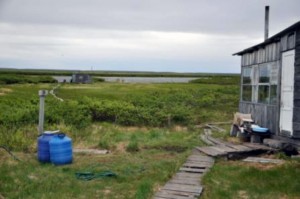
View of the boardwalk leading from the river bank to the houses (Photo: G. Schaepman-Strub, July 2013).
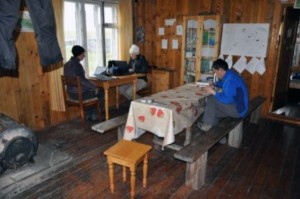
Infrastructure of the ‘big house’ looks cozy on the picture, but the wind is blowing through the walls and window frames, the stove is not strong enough to heat up the sleeping rooms and chairs definitely arrived at the end of their life cycle (Photo: G. Schaepman-Strub, July 2013).
As long as fresh water bucket gets filled and waste water bucket emptied… We even got soap and a towel for cleaning this year :-). The rest of the porch can be used as laboratory since a German group made it mosquito-safe two years ago.
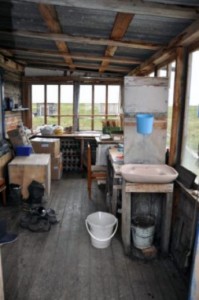
Main location for personal and group hygiene (Photo: G. Schaepman-Strub, July 2013).
On the other hand every year brings a few important improvements. In earlier years operation system messages popping up such as ‘please contact XXX for software update’ often meant the end of the data record for the season. This year, our colleagues brought a new communication system relying on geostationary satellites that provides more continuous and reliable connectivity, as well as the possibility to send and receive emails. A real improvement, thanks so much to Ko for arranging and sharing it! Otherwise this blog was not possible at all…With so many electronic devices charging of batteries remains an issue. This year there is a new fuel generator (yes, the ones from Japan indeed seem to be better than the cheap ones made in China, even Bingxi agrees on this!), but the diesel generator to run the closed-path methane measurement system broke last year and the new one is still somewhere, but definitely not on the site. To be independent from fuel we plan to invest into a windmill system that should be shipped later on this year. Given the potential fate of the batteries out here we however should reevaluate if another generator might be the better option in the end, but this needs to be discussed with our colleagues in Yakutsk and Amsterdam again.
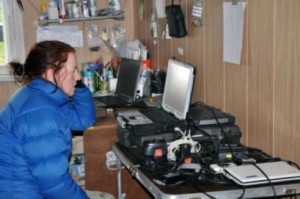
Angela Gallagher (Free University of Amsterdam) using the new satellite communication system (Photo: G. Schaepman-Strub, July 2013).
The same table serves as charging platform for the measuring instruments and computers.
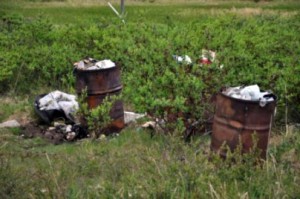
Trash gets burned, the remaining material is currently ‘stored’ in old fuel barrels (Photo: G. Schaepman-Strub, July 2013).
Recycling of acid batteries is an unsolved issue as it is prohibited to take them back by plane.
Anyway, an important task of every stay remains planning ahead for next year. If we need wood for boardwalks this has to be shipped or brought by truck on the frozen river from far away – preferably in winter time. And all of us definitely learned an important lesson – it does not pay off to bring cheap material out here – it usually breaks during the first summer, producing even more trash, and shipping costs might exceed the price of the device. An exception might be rubber-boots – at least the very expensive ones of Bingxi (120 Euros), brought here from the Netherlands, are leaking already in the second summer. But more about rubber-boots and personal equipment philosophies another time!
Abgelegt unter: General
5. July 2013 |
Gabriela Schaepman-Strub |
Keine Kommentare
by Gabriela Schaepman-Strub
Kytalyk, July 5, 2013
Yesterday evening we sat together with Lena, the cook, ordering food and all other essentials such as toilet paper. For planning future food supply, she wanted to know when people will arrive and leave from the site. We wrote a small shopping list, now hanging at the wall behind the eating table, in sight for those longing to get off the site …
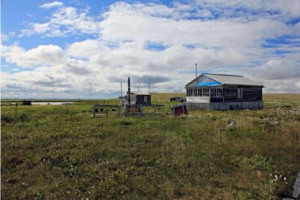
Overview of living facilities: Big house on the right, kitchen in the back of the image. (Photo: A. Erb, July 2012).
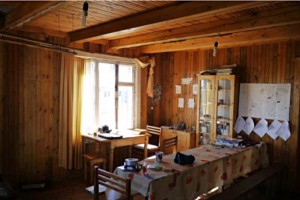
Living and working room in the big hut (Photo: A. Erb, July 2012).
One week has passed for the UZH group already, another two to go for me, another five for Maitane and Inge, it seems ages ago that we arrived to the field site… These passed days were rather intense for me – let alone for the two PhD students who are out here for the first time with all new impressions. Will be important to slow down a bit now and get into a daily working rhythm, passing some free time in the evening and weekends rather than coming late to lunch and solving problems that accumulated throughout the day after dinner. Up to now we only had a few free minutes before falling asleep at midnight.
One week: also a good time to review scientific progress: For both our projects the sites and plots are selected, the towers setup and running (yes, indeed THE day of first data records today!), plant species determined in one third of the diversity plots, work accomplished according to our schedules. All small problems solved, no big ones so far, neither work-wise nor socially. And tomorrow there will be a bania to relax and get us clean again!
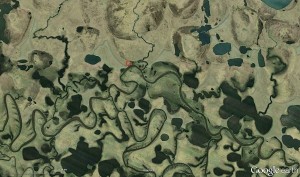
Map from the Kytalyk area with location of the facilities indicated (Map: Google Earth).
Abgelegt unter: Up and running
4. July 2013 |
Gabriela Schaepman-Strub |
Keine Kommentare
by Gabriela Schaepman-Strub
Kytalyk, July 4, 2013
This is the fourth time I am spending fieldwork time out here in Kytalyk. Every year is special in some way. 2008 was very wet, the water level of the river only went down very late in the season; 2010 was very hot. 2012 was the year of the flowering cotton grass, mimicking snow-covered landscapes, beautiful! This year is a lemming-year, meaning a promising year for the Siberian crane hatchlings. The Kytalyk nature reserve was established for the protection of the Siberian crane, a crane that is overwintering in China (Poyang lake) and migrating north to reach the tundra for breeding in summer time. It was the last crane that was scientifically described. The locals here call it ‘Kytalyk’, the name they also gave to this nature reserve. The Siberian crane is a sacred bird: there is a saying that once you have seen a Siberian crane, you will be happy for the rest of your life! Until now we have only seen sandhill cranes this year, a crane species with brownish feathers migrating from America, extending its nesting habitat further West every year. But also the Siberian cranes are doing well lately: according to ornithologists from Yakutsk, it’s population is increasing.
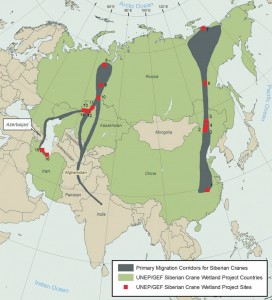
Project Map Migratory routes Siberian Crane & project sites (site 7 is the Kytalyk site) (Map: www.thegef.org).
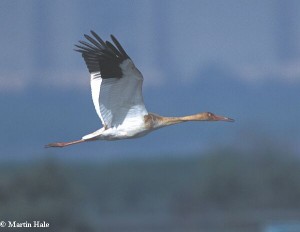
Siberian white crane in flight (Photo: Martin Hale, orientalbirdimages.org).
A science year!
2013 is not only a good year for Siberian cranes…. During the last 5 days we had been selecting an ideal site representing the two dominant vegetation associations of the area, carrying many kilos of equipment across the tundra, hammering holes into the permafrost for poles (the new drill working with steam of our colleagues did not work as expected – one coring tube is still stuck in the permafrost, while the old drill is broken), mounting radiation sensors, adjusting screws, connecting cables.
Yesterday we finally received the missing two boxes – they were located in Yakutsk and after our request on Monday they arrived with the next plane on Wednesday, delivered to Kytalyk by boat the same evening – real home delivery service!
The previously missing few essential parts allowed us today to get the two small energy balance towers up! After hundreds of hours of proposal writing, frustration about rejections, revisions, excitement after approval, selection of a PhD student, finally the vision of measuring the impact of different vegetation types on the shortwave energy balance in the tundra has become true. Thank you, Inge, for your substantial contributions, hard work, your patience and for sharing the enthusiasm that is needed to make this happen, especially on cold days like the one today!
PS: As soon as we have solved the problem with the software version of the data logger that has been out here in Siberia already (no opportunity to test that one at home…) we will report about the day of the first data recorded!
PPS: Stay tuned for first pictures!
Abgelegt unter: General
3. July 2013 |
Maitane Iturrate Garcia |
Keine Kommentare
by Maitane Iturrate
Kytalyk, July 3, 2013
During this year’s first field campaign, my main objective of the field work is to characterize, in terms of biodiversity, the research area, including a floodplain, lowland tundra and a hillside. To reach this objective, measurement plots will be selected in these areas, the species composition is determined and important plant traits related to the radiation balance are measured in the tundra. These include leaf length, width and leaf optical properties, height and architecture of the different plants.
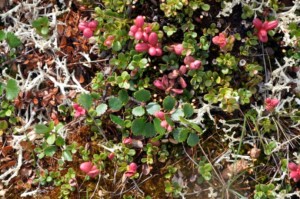
Mixed dry vegetation patch, including Betula nana, Vaccinium vitis idea, sedges, brown mosses (Photo: G. Schaepman-Strub, July 2010).
Simultaneously, soil measurements will be taken in order to analyze the correlation between abiotic traits (i.e. soil moisture, pH, Active Layer Thickness…) and the plant traits measured. In addition, other vegetation relevées will be selected and measured using the Braun-Blanquet approach. This approach will allow us to assess the phyto-sociology of the area (plant associations).
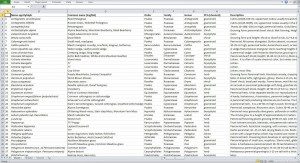
Preliminary species list of the Kytalyk area based on previous field campaigns. This year a botanist from St. Petersburg will join us to complete the local species list as a reference for expected future changes (Table: M. Iturrate, June 2013).
Most of the results obtained will be used for radiative transfer modeling. 3D objects for the DART model will be designed using results from the measured plant traits. The aim of the 3D object database is to create different scenarios of plant compositions and to study the behavior of the impact of short-wave radiation within them. The results obtained will be validated by removal experiments reproducing the scenarios created (but this will be another field campaign 🙂 ).
URPP GCB Project 1: Cross-scale quantification of vegetation–atmosphere interactions and biodiversity change
Gabriela Schaepman-Strub, Pascal Niklaus, Maitane Iturrate, Inge Juszak, and NN (position currently open)
We investigate biodiversity-effects on vegetation-climate interactions. For this, we combine process-based modelling and statistics to link terrestrial biodiversity measures, in-situ proxy observations of energy and carbon fluxes, and corresponding satellite-inferred landscape-scale products (albedo, vegetation biochemistry, canopy structure, evapotranspiration). The 3D radiative transfer model DART will be used to explore how species diversity influences albedo, canopy light distribution, and ground level radiation throughout the growing season. The parametrization of DART requires the definition of a limited number of plant functional groups through selected traits that are representative of the functional and taxonomic diversity of tundra vegetation, but at the same time adapted to the intermediate complexity of DART. Running DART in the energy budget mode will allow investigating the small spatial scale relation of micro-climate with functional trait diversity. Finally, the model will be parametrized at the landscape level, integrating small-scale patches of differing diversity and size to study the contribution of micro-climatic feedbacks by communities to the landscape scale.
Predictions will be validated using field observations at the patch scale and satellite-inferred land surface products at landscape scale. Upscaling procedures for in-situ proxies will be developed. Given the complexity of processes, we will aim at simplifying the relation of modeled radiation fields with satellite observations and in-situ data at respective spatial and temporal scales.
Abgelegt unter: Up and running
by Inge Juszak
Kytalyk, July 2, 2013
Very north (71°) and very east (148°) Siberia is composed of lots of permafrost, wetlands and patterned vegetation. That’s why I join the mosquitoes this summer in Kytalyk. I’m interested in assessing the influence of vegetation, mainly sedges and dwarf-shrubs, on the energy balance of the soil. While the sedges are supposed to reflect more solar radiation back to the sky, the shrubs might cool the surface by shading. I want to measure both components and find out if this is true for the whole summer. Further, to investigate if vegetation has an effect on soils, I measure also active layer thickness. That is the depth of mud and water on top of the frozen soil (the activity is walking through it). This depth is the final result of the energy balance, the more energy available, the deeper the active layer. In addition to the radiation measurements I’ll have some sensors for air and soil temperature, soil heat flux and moisture. I’ll count the leaves of my plants, too. That will be the hardest task to perform, probably, but I will need this information to compare different plots. Based on extended observations around the area, I will test if the plots with all the sensors are nicely representative of all shrubs and sedges in the area.
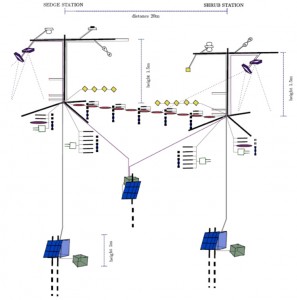
Setup of the energy balance system at Kytalyk being placed on two contrasting vegetation types, namely sedges and dwarf shrubs. Sensors include above-ground short- and long-wave radiometers, time-lapse cameras following phenology changes, as well as below-ground temperature sensors. The system is solar energy powered and data are continuously stored on two data loggers (Graph: I. Juszak, 2013).
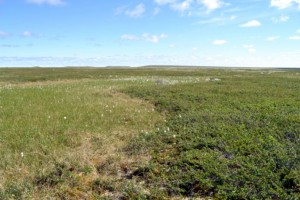
On the left a sedge (mainly Eriophorum angustifolium) patch, on the right a dwarf shrub patch dominated by Betula nana is seen (Photo: G. Schaepman-Strub, July 2012).
This project is funded through the Swiss National Science Foundation (SNSF), contributing to the URPP GCB Siberia activities.
Abgelegt unter: Up and running
1. July 2013 |
Gabriela Schaepman-Strub |
Keine Kommentare
by Gabriela Schaepman-Strub
Kytalyk, July 1, 2013
It’s Illias second birthday today! Last year we celebrated his first birthday here in the tundra already. Lena, Illias mother and our cook, prepared a wonderful blue birthday cake for him last year and a lot of food for the whole group of people, some even came from Chokurdakh to celebrate.
Lena is probably the most important person out here. Days are long, right now it is still cold and people are getting tired and hungry. Luckily, we don’t have to come back from the field and cook for ourselves ….
We get breakfast at 9hrs. Not my favorite meal of the day – it’s Lena’s choice of pasta, oats, porridge, rice or some other grain cooked in sweet milk.
I am always eager to make it back on time at 13hrs for lunch – usually a soup, my preferred one with fresh fish from the Berelech (Rus: Бёрёлёх) caught the same day – much better than any fine French bouillabaisse! The dinner is usually some pasta or buckwheat (Rus: грейчиха) with a few spoons of canned meat. Some cucumber or tomato salad after the supply boat has been here, later on cabbage or canned vegetables. Lots of cookies and sweets, and that’s what is keeping us happy for most of the days. We could of course bring more fresh food out here, but the choice in the store in Chokurdakh is limited to very few fruit and vegetables, while bringing food from Yakutsk means paying CHF 6.50 (USD 7.00) overweight per kilogram! We are really very thankful to Lena – she is indeed a good soul staying out here with us the whole summer, cooking on a wooden stove (Rus: печка), making the best out of the simple ingredients she has got, and sometimes even spoiling us with fried pancakes or tundra-made reindeer (Rus: пельмени) (yes, including making the dough and folding 100 ‘ravioli’ out here!). Lena is getting the reindeer meat from the permafrost cellar, a deep hole in the ground with a small hut on the top. The reindeer legs are lowered down to the cellar on a rope, and we use the same system to keep our plant samples cool. This cooking story reminds me that we have to saw and chop wood tonight – floating trunks from the Indigirka that were transported to the station by a pontoon – to make sure that Lena has enough wood to cook during the next few days.
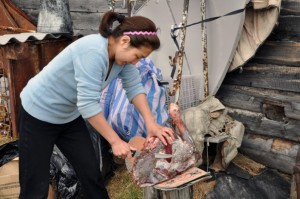
Lena – our fantastic cook – cutting reindeer meat (Photo: G. Schaepman-Strub, July 2013).
Abgelegt unter: General
30. June 2013 |
Maitane Iturrate Garcia |
Keine Kommentare
by Maitane Iturrate
Kytalyk, June 30, 2013
June 28, 2013: At last, everything is ready for embarking the boat. It took us almost three hours and some discussions with the owner of the boat, because of all our equipment and luggage. The weather does not look nice, grey clouds are approaching and the wind is blowing strong. Just when we are about to board, heavy rain starts and the Indigirka – a couple of hours ago seemed to be a calm lake – now looks like a wavy sea! I’m sitting on the battery box on top of the equipment, so I can see how Chokurdakh disappears on the horizon. Suddenly, we stop in the middle of the river, with the engine turned off. Ivan, our boat captain, jumps to the back of the boat and tries to solve the problem. Two minutes later, we are ready to continue. We are lucky because the rain stops shortly after we have left, and we enjoy the landscape. Amazing!
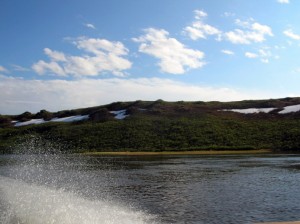
On our way to the research station (Photo: M. Iturrate, June 2013).
Three hours later, we are arriving at the research station. I can’t see it straight away, because of my position on the boat and the sturdy life-vest. But after we have stopped and I can finally disembark the boat. I have no words to describe what I see in front of me: Incredible! It is much better than what I have expected!
All our expedition equipment is in the main building. But first, time for our first warm meal on this day (at 20.45hrs local time). For me, the most wonderful soup I have enjoyed for a long time, so warm, so tasty and delicious.
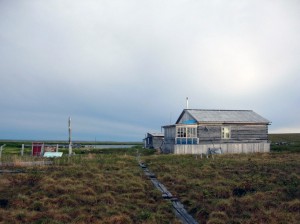
The main building of the Kytalyk research station (Photo: M. Iturrate, June 2013).
June 29, 2013: Today is a cold, cold, cold day! We are walking around the area to gain a first impression of the location for our plots. Lastly, I can see my little plants I studied from books and pictures and now I can work a while with them. They are so tiny and beautiful!
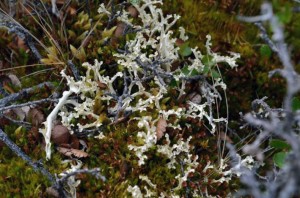
Lichen and mosses in the tundra (Photo: M. Iturrate, June 2013).
We are spending the day unpacking the rest of our things, tidying and thinking about the schedule of our fieldwork. During the evening, we are visited by three people who are spending some days ‘birding’ with Sergei, a researcher from Yakutsk. So again, midnight and we are ready again to sleep. However, this time the sleeping is not very good, it’s so cold, even inside the sleeping-bag. At 3 o’clock in the morning – of course daylight outside – freezing cold air is blowing through those several holes in the walls. I put on some extra pieces of clothes and try again to fall asleep.
June 30, 2013: We are finally selecting our measurement plots. I manage to mark the first of my 15 plots placed at the hill before lunch. Breakfast and lunchtime are really nice today, especially after the cold day of yesterday. I feel that the cold is still inside me.
I’m helping Inge to transport the equipment she needs for her two radiation towers to the patches selected by her. It is hard work walking through the tundra, but finally everything found its place now. Mosquitos are everywhere and they are a bit annoying. Luckily, the head-net works perfectly. We are really motivated to finish fast because today is also bania (Rus: баня) day (sauna).
The bania is ready, with warm water and something to drink after that … Sorry, I have to leave. Tomorrow more.
Abgelegt unter: Starting up
29. June 2013 |
Michael Schaepman |
Keine Kommentare
by our staff writers
June 29, 2013
No mobile phone tower nearby, project loon (balloon-powered internet access) not yet arrived in Kytalyk, and some communication satellites do not provide guaranteed coverage in our location (such as Thuraya and Inmarsat). So how do you communicate in such a remote location?
Luckily there is a constellation of 66 active LEO (low Earth orbiting) satellites, operated by Iridium. LEO satellites are located on a (quasi-) polar orbit at about 780 km height.
In the field, we use a Iridium 9575 satellite phone for communication. The phone is has a built-in GPS emergency button (SOS messaging) and interface to advanced location based services.
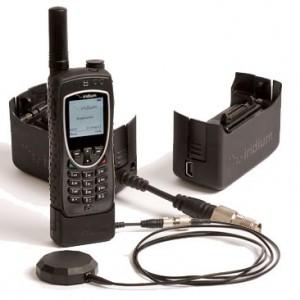
Satellite phone with external antenna (allowing you to call from inside the container, without the risk being attacked by mosquitoes) (Photo: groundcontrol.com).
The satellite phone communicates in the L-band spectrum (1616-1626.5 MHz) and it’s antenna can be used for GPS and phone communication at the same time. You can recognize Iridium numbers since they use the virtual country extensions +8816 and +8817.
There is also a short burst modem on the site in operation with another satellite phone, allowing sending e-mail or other messages.
The SOS messaging of our satellite phone is configured to activate a number of services automatically. First, it will send an SMS with location information to GEOS SAR. GEOS operates a commercial global alerting post for satellite emergency notification devices, providing real time monitoring and response, as well as search and rescue services (SAR). All our expedition participants are members of GEOS SAR. Once SOS messaging is activated, the Intl. Emergency Response Coordination Center (IERCC) will coordinate the rescue operation. At the same time, an e-mail message will be sent to responsible persons at the University of Zurich. And last, it will call a phone number of a responsible person at the University of Zurich. We strongly hope that we do not need to make use of this service.
Our location-based services are configured to sending GPS coordinates through an SMS gateway to pre-configured numbers. Once activated we’ll be receiving up-to-date information on position, altitude, date, time, and a link with locations projected on a Google Maps interface.

Location based service SMS on a smartphone (Photo: M. Schaepman).
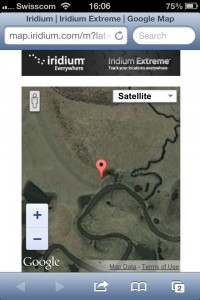
Visualized position on a smartphone (Photo: M. Schaepman).
This is all fine. The risk is as usual in the battery. Satellite phone charging gets priority on the site, where power production and consumption is limited!
This techno–stuff is very interesting, but how do I call them?
Don’t. We won’t post numbers here. Drop us a message if you can’t resist. Usually we send them an SMS through a mail gateway or an SMS service with a call request, since calling from the satellite phone is cheaper than from elsewhere. All expedition participants have been allocated satellite phone time to communicate, as they desire.
Abgelegt unter: General
28. June 2013 |
Inge Juszak |
2 Kommentare
by Inge Juszak
Chokurdakh, June 28, 2013
Today we took the last plane of our journey to the research site, from Yakutsk to Chokurdakh. Compared to the flights from Zurich and Moscow this one was a real adventure in an Antonov AN- 24 PB with about 30 people and a lot of cargo.
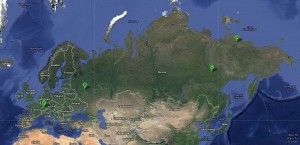
From Zurich (Switzerland) to Chokurdakh (Russian Federation) (Map: Google Earth).
The airplane (it seems it is still the same since the first Siberia expedition in 2008 and many years before) is said to be robust, and keeps on going since decades. For those avionic freaks amongst you, check out the details for this Antanov AN-24!
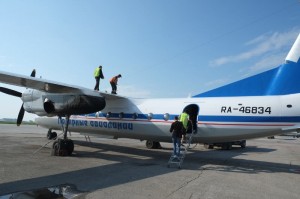
Loading the aircraft on the taxiway in Yakutsk is a ‘do it yourself’ job … (Photo: I. Juszak, June 2013).
We were really lucky, the weather was great and we could see the Lena river, two mountain ranges, the taiga and the tundra with huge, partly still ice-covered lakes. I was most lucky as I had a window seat, so I stopped taking photos just for the lunch.
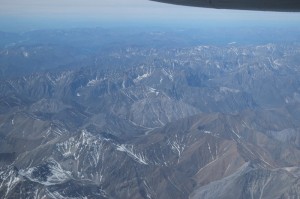
Chrebet mountain range as seen from the air between Yakutsk and Chokurdakh (Photo: I. Juszak, June 2013).
Landing in Chokurdakh was beautiful, we could see the last trees, little lakes, streams and the polygonal structure of the permafrost.
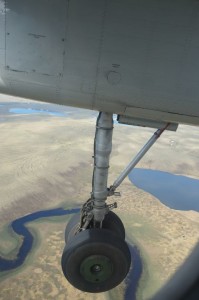
Approaching Chokurdakh airport (IATA: CKH, ICAO: UESO), still 46 m above sea level (Photo: I. Juszak, June 2013).
At the airport grimy looking soldiers and airport officers kept me from taking pictures of the humpy air stripe or the firemen waiting in their cars with running engines, just in case something would happen. In Chokurdakh we are the main attraction and luckily Ivan from Wladiwostok is here and translates what happens.
At the moment we are waiting until we can leave for Kytalyk. I saw the tiny boats already, and I wonder how we can fit all the luggage, our instruments we send by post weeks ago and ourselves. The weather is still beautiful and I’m looking forward to the boat trip.
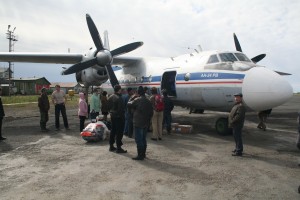
Unloading the baggage, again a DIY job (Photo: G. Schaepman-Strub, 2008).
Finally, arrival at the final air destination. Further travel is by boat to the test site in Kytalyk.
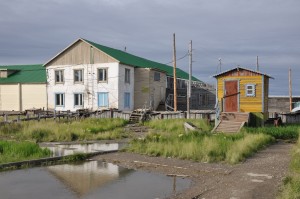
House in Chokurdakh (Photo: G. Schaepman-Strub, 2010).
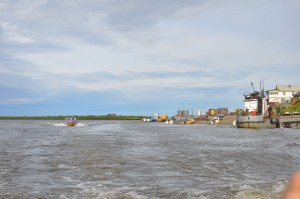
Leaving Chokurdakh by boat on the Indigirka river (Photo: G. Schaepman-Strub, 2010).
We will be coming back to you once installed on the site. From now on, communication will be sparser, since we use a satellite phone with limited bandwidth to stay in contact.
Abgelegt unter: The first days
27. June 2013 |
Maitane Iturrate Garcia |
Keine Kommentare
by Maitane Iturrate
Yakutsk, June 27, 2013
08.00 hrs (midnight in Zurich)
Today it is grey, windy and cold. We are ready for having breakfast, although still suffering from an awful jet-lag. Fruit, cheese, butter, yogurt … the table is full of all the luxurious things that we will miss in Kytalyk!
10.00hrs
We have to go to buy the last things before flying to Chokurdakh: batteries, life-vests, spikes … Raincoats, cameras, the shopping list and money, let’s go. We are glad to be able to go to the town to buy things, until we open the door: it’s raining cats and dogs!
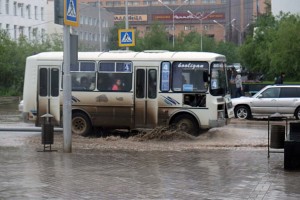
“Tropical” storm effects in downtown Yakutsk (Photo: I. Juszak, June 2013)
The “roads” have turned to be rivers and the sidewalks and pedestrian crossings are lakes. It’s very difficult to walk along the muddy paths and in less than 10 minutes it feels like having a second skin (our trousers). But, at last, we manage to finalize all shopping without drowning. And the reward is a great lunch in a cafeteria. We are having a cup of tea and some unpronounceable little breads filled with different stuff: fish (type 1), fish and onions (type 2), fish (type 3), vegetables, rice and meat. I think I will love Sakha gastronomy.
14.15hrs
Inge and I are going to buy the heavy things listed on the shopping list. Our collaborators from the IBPC are helping us (thank you very much Stas and Sasha!). But first we arrange a group picture at the entrance of IBPC.
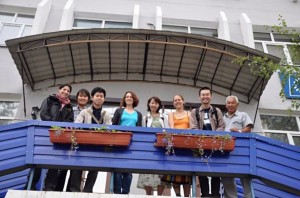
From left to right: Maitane Iturrate, Stas Ksenofontov, R. Shingubara, Gabriela Schaepman-Strub, A. Sugimoto, Inge Juszak, T. Morozumi , Wasia (our fantastic driver) (Photo: G. Schaepman-Strub, June 2013)
We go by one of their cars. This time the trip is a little bit less scary than the first one (from airport to the pension), but I don’t know if I will get used to the way of driving here. We stop at four different places. In-between one of the stops, we have a “technical” problem on the road: a bull is trying to cross the road on a roundabout. Seeing from the reaction of the driver, I assume that this is something quite common for them, but for me it is a bit surprising. A bull! We finish the shopping quite soon. Now everything is ready and we are ready for the evening, and the plan looks great: having dinner enjoying local gastronomy in a restaurant and, after that, a typical dancing spectacle as preparation for the summer festival that will take place during the weekend (and we will miss it because we will already be in Kytalyk!).
21.45hrs
The evening schedule has undergone a little change. We needed to wait so long for being served that the show is already over when we arrive. The fish soup was nice and the deer meat with vegetables and potatoes (“patatas bravas” style) was also good! We are walking through town and take pictures of typical buildings that are suffering from the consequences of being built on permafrost: the electrical installation, the water pipe system …
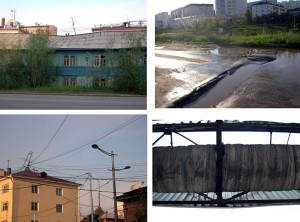
From left top to bottom right: Consequences of permafrost on traditional buildings and on road conditions, electrical installations, while walking under the aerial heating pipe system (Photos: M. Iturrate, June 2013)
22.45hrs.
The day has come to an end (well, sunset is at 23:15 PM, sunrise at 03:25 AM with almost continuous twilight …). Summarizing the day, we did three things: shop for essentials, eat and take pictures. Yakutsk leaves again lasting impressions: everything is so different to all I have seen before. It is incredible to see the problems that they have to deal with when infrastructure conservation is needed due to permafrost. The ambiance is also very much different: the light, the dust in the air, traffic, and so forth. All factors together make us feel like traveling through time: A very special experience not to miss!
Abgelegt unter: The first days































